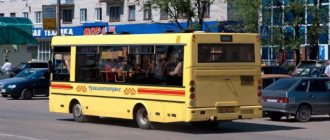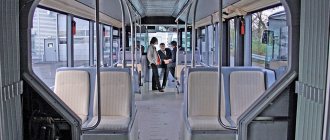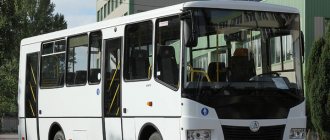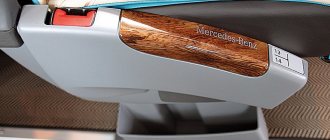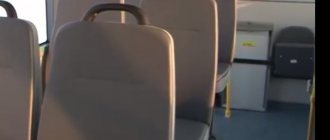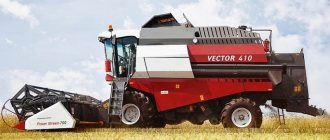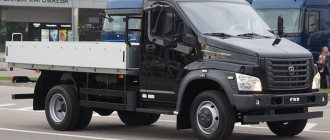Details Category: Buses and trolleybuses Published: 06/23/2016
- general description
- Salon
- Driver's cabin
- Specifications
- Video presentation
The PAZ 2256 “Vector-3” bus is a small-class bus produced by the Pavlovsk Automobile Plant. It was first presented on May 12, 2015 at an exhibition called “World of Buses - 2015”. Used in urban and suburban passenger transportation. Vector-3 is the latest model in the line of Russian buses, which has high hopes. First of all, this model should gradually displace outdated van buses from city routes. PAZ 2256 is a fairly compact bus that can carry up to 33 passengers, with 20 seats. Passenger seats are very comfortable and have a three-row layout. It was thanks to the three-row seat layout that the car received its name. Initially, Vector-3 was supposed to be called Vector-7 (based on the length of the body), but during the work the number 7 disappeared, and in its place the usual 3 appeared. Thanks to its small dimensions, the bus is quite natural to wear out in city traffic and is highly maneuverable.
Salon
The Vector-3 bus is built on the Isuzu chassis and has the following overall dimensions: width - 1.96 m, height 2.8 m, and length 7.36 m. These dimensions indicate that the PAZ 2256 Vector-3 on a city street will take up no more space than a typical Crafter or Sprinter minibus. At the same time, it is simply stupid to compare these models in terms of convenience for passengers, since Vector-3 is equipped with two full-fledged automatic doors. Not a single van has automatic rear doors, and it is not often possible to see an automatic front door.
Read Bus LIAZ 6213: the first Russian articulated bus
Inside the bus, thanks to the well-designed three-row seating layout, there is a lot of space, allowing passengers to feel comfortable. In general, due to the comfortable internal height, wide passage and convenient location of the handrails, the bus is increasingly gaining popularity among passengers. Also, one cannot fail to mention the pitch of the seats; it deserves special praise, since even a very tall person can feel comfortable. Initially, Vector-3 was designed to fit the dimensions of a “vanbus” and this was the main idea, but if you look at the photo of the front of the bus, you get the impression that this is some kind of huge tourist bus. In a few words, the bus can be described as “a bus designed for maximum comfort of people.”
Before us is a completely new direction of activity of the GAZ Group, its new Vector -
Vector 3 .
M-Park Inspection
style .
Vector 3
- the newest model in the line of “Russian buses” of the GAZ Group.
Vector 3
is designed to work in large cities in minibus mode.
Its task is to gradually oust “sawed-down” “vanbuses” from routes. And, you know, Vector 3
enough strengths to solve this problem.
01
. Firstly, the dimensions. The width is 1.96 m. Only 1.96 m. This is even slightly less than that of the VW Crafter, Mercedes-Benz Sprinter and is absolutely comparable to their other “classmates”.
02.
The average length of “vanbuses” converted from large European all-metal vans is 7 – 7.3 m. The length of the small
Vector 3
is 7.36 m. That is, on a city street it will take up exactly the same space as a Crafter or Sprinter minibus.
03.
At the same time,
Vector 3
two full-fledged automatic entrance doors. Not a single van has an automatic rear door!
04.
A full-fledged bus, initially designed as a bus in the dimensions of a “vanbus” - this is the main idea embedded in
Vector 3
. This is also evidenced by the original “purely bus” design. If you didn’t know the dimensions, then from this photo it was quite possible to assume that in front of us was some kind of large tourist liner.
05.
The optics here are lens ones, made by Hella.
06.
The rear optics are also made in the tradition of large buses and even have some rocket and space motifs.
07.
Vector 3
still looks a lot like someone
08.
Certainly!
Real
buses were produced in Russia ?
They were made by the joint venture “Russian Buses - Marco” since November 2007, and then the topic somehow died down by itself. And although it was a completely separate manufacturer, the physical production of Reals was located on the territory of PAZ. They made several hundred of them, but I managed to spot Real
only once, in remote Medvezhyegorsk, in Karelia.
09.
Drivers didn’t really like Real Madrid.
It's not surprising. It's hard to love a bus that's hard to drive. The Reals did not have a separate driver's door. On Vector 3
this flaw was corrected.
Remark by M-Park
10.
To be fair, we note that after the death of the Russian Buses - Marco joint venture and the termination of relations with the GAZ Group, the Brazilian company Marcopolo found a new partner in KAMAZ.
So in 2012, the KAMAZ-Marko JV LLC appeared on the premises of NefAZ, which produces similar buses to this day, but under the name Bravis
and on a KAMAZ chassis. Bravis now has a driver's door, but...
photo by Denis DEMENTYEV
11.
But the driver's door
of Vector 3
, you see, is made much more competently.
12.
The Vector 3
bus driver’s workplace is quite comfortable. And a special compliment goes to the designers for the design of the driver’s partition. It is very convenient to hold on to; being transparent, it leaves an open view of the road for the passenger, while performing its main function well.
13.
The Vector 3
has an
Isuzu
on the steering wheel .
Yes, the chassis for Vector 3
is supplied by this Japanese company.
Isuzu
bus chassis has its own instrument panel, but the instrument panel and steering column are exactly like those of the
Isuzu Elf
.
14.
Automatic door opening buttons are another external difference between the bus version of the dashboard.
15.
Now let's study the passenger part
of Vector 3
.
The compact engine casing (3-liter, Isuzu 4JJ1
, 124 hp) made it possible to place an additional passenger seat at the right front window. The window sill handrail, by the way, is very well located. Fits comfortably in the hand.
16.
The urban version has a three-row layout.
In the interior of the Vector 3,
the advantage of a classic bus over a “vanbus” is very clearly felt - a more convenient space for passengers, which was not adapted, but was originally designed for people.
17.
By the way, it was the three-row layout that gave the number in the index.
Initially, Vector 3
carried the name Vector 7 (along the length of the body).
However, during the work process, the number “7” disappeared from the official name. The name Vector 7 was replaced by the name Vector 3
(an urban modification with a three-row layout). The suburban version with a four-row layout will likely be called Vector 4.
18.
However, the salon is good! Comfortable internal height, wide passage. “Vans” do not provide such “aquarium” sensations.
19.
The seat pitch is also commendable. With my height (185 cm), sitting is absolutely comfortable.
20.
To date, a little more than 10 copies
of Vector 3
. We studied No. 2. This is a test and demonstration batch for now.
21.
Vector 3
will be freely available for purchase in 2016
In terms of build quality, I really liked this particular example. Everything was neat, I couldn’t find anything to complain about. But we must remember that this is an “exemplary” specimen.
Whether it will be possible to maintain such build quality on production machines is an interesting question. Well, all the more interesting it will be to look at the serially commercial copy. As for the layout solutions, the newborn Vector 3
fits perfectly.
We thank RUSAVTOPROM LLC
(Borisov) for providing
Vector 3
.
Driver's cabin
Many motorists find similarities between the PAZ 2256 Vector-3 and Real buses, which were produced in Russia for some time. And indeed, there are still some similarities. Real buses have been produced since 2007. Despite the fact that this is a completely independent and separate manufacturer, these buses were produced on the territory of PAZ. Production cannot be called large-scale; in total, about 100 of these machines were produced, after which they disappeared from the market. This is not surprising, because these buses had many shortcomings, in particular, the design did not include a driver's door, which made it difficult for the driver to get behind the wheel. In Vector-3, this drawback was completely eliminated and even more, the door was made very competently, in comparison with other buses.
The Vector-3 bus driver's workplace is very comfortable. A very comfortable and moderately soft seat provides comfort throughout a long working day. The bus chassis from the Japanese company Isuzu has a similar instrument panel, but the instrument panel and steering column are made exactly like those on Isuzu Elf trucks. Differences in the dashboard include buttons for automatically opening and closing doors. The driver's partition is made very competently, since you can hold on to it, and being transparent, it gives passengers a full view of the road.
Read Bus PAZ 4234 - a proven worker on Russian roads
Specifications
Dimensions
- width – 1960
- height - 2800
- length - 7360
- Weight - 6700
Engine
- Engine - Isuzu 4JJ1
- Volume - 3l
- Power - 124 hp.
- Environmental standard - Euro 4
Additional equipment of the car includes an air conditioning system, a digital tachograph, an audio system, a navigation system, as well as an internal and external video surveillance system. Thanks to the compact design of the engine casing, it became possible to locate an additional passenger seat in the front part of the bus. The headlights are equipped with optical lenses from Hella. The taillights are also designed in the style of large buses and are quite stylish and attractive in design.
additional characteristics
- Maximum speed - 95 km/h
- Transmission - 5-speed manual
- Number of doors - 2 pcs.
- Number of seats - 22
- Maximum capacity -33
Check-in is not a joke
Let me make a reservation right away: they didn’t let me go on the route, limiting our tandem with “Vector” to the boundaries of Motorcade 1417. However, their territory is large, and the buses placed here and there created natural barriers and labyrinths, allowing us to very accurately simulate work on a city route , except perhaps without a rotation of passengers.
However, I had enough passengers in the cabin. Only a few people, but they were able to fully convey the atmosphere of the real route. “And the clients drove much more carefully here!”, “You’re not carrying firewood!”, “Why turn so sharply?!”, “I forgot to close the door!” – it is clear that all this was said as a joke, however, my colleagues still failed to distract me from driving the car.
Technical characteristics of the PAZ-225620 bus (Vector 3)
| Total weight, kg | 6720 |
| Curb weight, kg | 4350 |
| Passenger capacity, persons including sitting | 33 20 |
| Permissible load on 1st/2nd axles, kg | 2560/ 4160 |
Engine:
| Isuzu 4JJ1 Turbodiesel I-4 2999 124 at 2600 min-1 354 at 1500 min-1 |
Transmission:
| Isuzu MYY5T Mechanical 5/1 |
| Suspension | Dependent, spring, with shock absorbers and stabilizer |
| Brake system | Hydraulic with vacuum booster, dual-circuit with axial division into circuits |
| Wheel formula | 4x2 |
| Minimum turning radius, m | 7,8 |
| Fuel tank capacity, l | 100 |
The bus turned out to be good. There are no complaints about the dynamics or the brakes - everything is adequate and predictable. Remembering some of the Vector 3 classmates, I was afraid that the car would roll heavily in turns - it didn’t happen at all. It seems that the reason for this stability is the presence of a stabilizer on the rear axle and an overall low center of gravity. It feels like even the stated 13 people standing will not be able to significantly upset this balance. Not bad!
The first complaint appeared at the first stop, or rather, after the opening of the 1st service door. As soon as the door swung open, the view in the right mirror was reduced by exactly half, precisely to that part of it in which the process of boarding the 2nd door is visible. The problem can be cured, but to do this the plant will have to replace the mirror bracket with a longer one.
Since we are talking about something that would be nice to fix, I would like to remind the designers to provide hooks for the driver’s outerwear. This is not Africa, after all, and in the cold season you need to hang your jacket or coat somewhere.
By the way, on the engine cover itself I would like to see stampings for small items, reels with tickets, etc. I don’t think that buses of this size are planned to work with conductors, which means there will be a problem.
And the last wish: provide a place to store the driver’s belongings. Currently, there is nowhere to hide even the most compact bag with documents.
